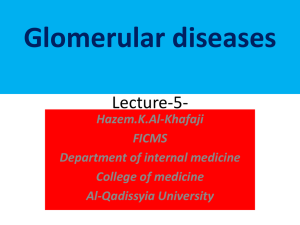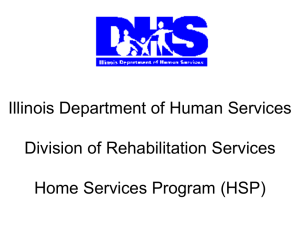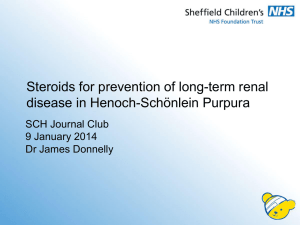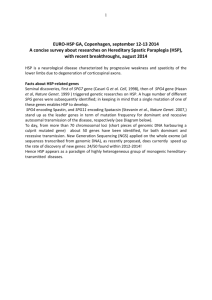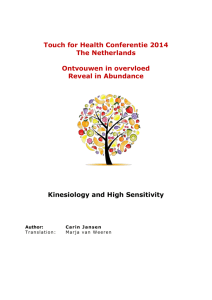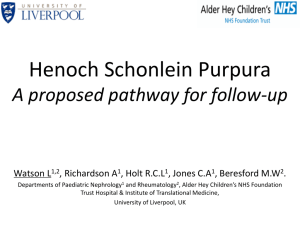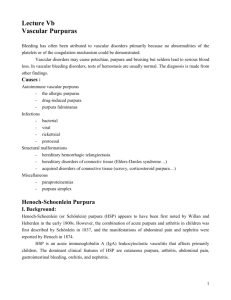4 HSP case presentation
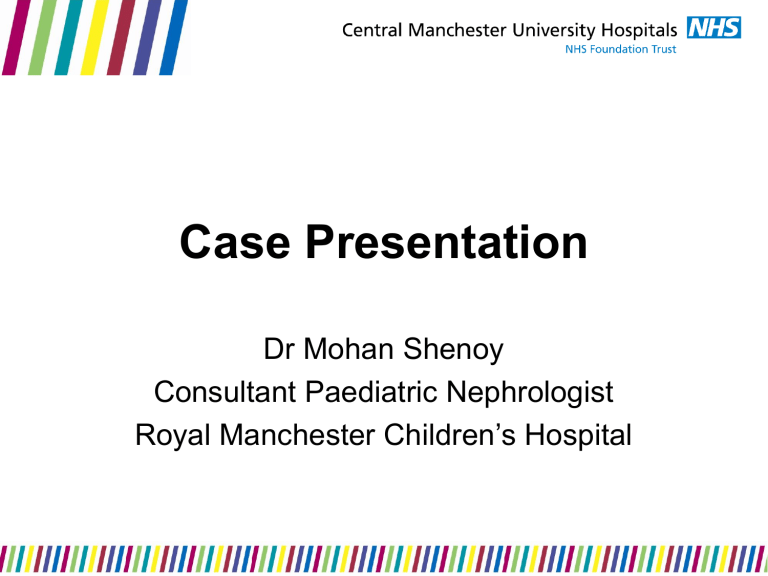
Case Presentation
Dr Mohan Shenoy
Consultant Paediatric Nephrologist
Royal Manchester Children’s Hospital
History
• 6yr girl
• Presents with non blanching palpable purpuric rash over extensor surface of arms and legs
• Ankle pain
• Well child
• BP 106/60
• Urine – NAD
Examination
HSP: Background
• Most common childhood vasculitis
• Incidence of HSP: 135-200 pmcp
• Highest among 4-6 year olds – 700 pmcp
Stewart M et al, Eur J Pediatr 147:113-115, 1988
Gardner-Medwin J et al, Lancet 360:1197-202, 2002
HSP: Diagnostic criteria
Palpable purpura (mandatory) in the presence of at least one of the following four features:
– Diffuse abdominal pain
– Arthritis (acute) or arthralgia
– Renal involvement (any haematuria and/or proteinuria)
– Any biopsy showing predominant IgA deposition
Ozen S et al Ann Rheu Dis 65:936-41, 2006
Evaluation of a child with HSP
• Weight
• Blood pressure
• Urine dipstix for blood and protein
• If dipstix positve for blood or protein:
– Urine microscopy
– Urine protein creatinine ratio
– U&E, LFT
Investigations
Only if diagnosis uncertain
• FBC
• Coagulation
• ASO titre
• C3 and C4
• Igs
• ANA, ANCA
Case history
• So…
• In our patient with HSP with no renal manifestation, what follow-up and monitoring is required?
HSP – Onset of nephritis
Time of onset of urinary abnormalities after the diagnosis of HSP
1
Weeks after HSP diagnosis
2 4 6 8 24
% 37 54 84 90 91 97
Narchi H Arch Dis Child 90:916-20, 2005
Recommended follow-up
• BP & urine dipstix for
– week 1-6 weekly
– Week 7-24 monthly
• Discharge at 6 months if no urinary abnormality
Narchi H Arch Dis Child 90:916-20, 2005
Can early steroid therapy prevent onset of HSP nephritis?
Early steroids to prevent onset of HSP nephritis
• A large UK prospective study
• 353 children randomised to steroids or placebo
• No difference in the incidence of proteinuria at
12 months
– 19/145 steroid vs 15/145 placebo
Dudley J et al Pediatr Nephrol 22:1457, 2007
Cochrane review 2009
Therefore…
Early steroid therapy to prevent onset of
HSP nephritis cannot be recommended in children presenting with HSP
Case history
• Child presents 3 weeks later
– Frank haematuria
– Protein +++
– BP 110/70
– Not oedematous
– Creat 45, albumin 34
– Urine protein creatinine ratio 285mg/mmol
HSPN - Presentation
15%
20% 22%
43%
Hematuria
Haematuria+ proteinuria
Nephritic
Nephrotic+ nephritic
Indications for Renal Biopsy
• Acute nephritis
• Nephrotic syndrome
• Persisting heavy proteinuria
– Urine protein creatinine ratio >200mg/mmol for 2 weeks
Discuss with Nephrologist
• Hypertension
• Abnormal renal function
• Macroscopic haematuria > 5 days
• Persisting proteinuria
Case history
• Weekly review
• Upcr improves 154 and then 75mg/mmol
• BP and creatinine normal
Prognosis of HSP nephritis
• Significant variability
• Chronic kidney disease 2-20%
• 2% of children with ESKD in UK
Outcome of HSP nephritis
• Unselected study
• 270 children with HSP over 13 years
• Renal involvement at presentation – 20%
• Mean follow-up 8.3 years
• CKD in only 3 (1.1%)
Stewart M et al, Eur J Pediatr 147:113-115, 1988
Clinical Presentation and
Outcome
100
80
60
40
20
0
IHP NS AN AN &
NS
Cameron JS et al Oxford Textbook of Clinical Nephrology
ESKD
Active disease
Minor disease
Normal
Biopsy grade and Outcome
100
80
60
40
20
0
1 2 3 4
ISKDC Biopsy grade
5
Cameron JS et al, Oxford Textbook of Clinical Nephrology
ESKD
Active disease
Minor disease
Normal
Long-term outcome of HSP nephritis
• 78 children with HSP nephritis
• Various immunosuppressive regimens
• F/U 23 years
• Active renal disease: 7.5%
• ESKD: 14%
Goldstein et al Lancet 339:280 –282 , 1992
Outcome of HSP nephritis
• 16/44 pregnancies – proteinuria+/hypertension
• 7 patients – deterioration following complete recovery at 5 year follow-up
Goldstein et al Lancet 339:280 –282 , 1992
Take home messages
• No risk of CKD if urinalysis normal at 6 months
• In unselected patients, the risk of CKD < 2%
• Presentation with acute nephritis and nephrotic syndrome high risk of CKD
• Late deterioration in renal function can occur and all children with significant nephritis require life long monitoring

